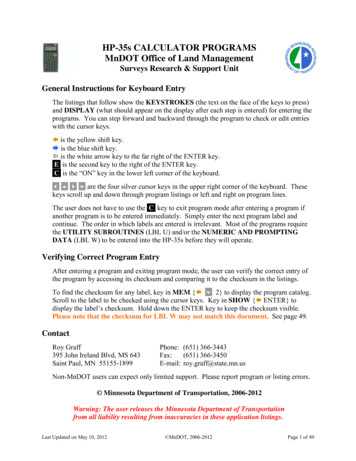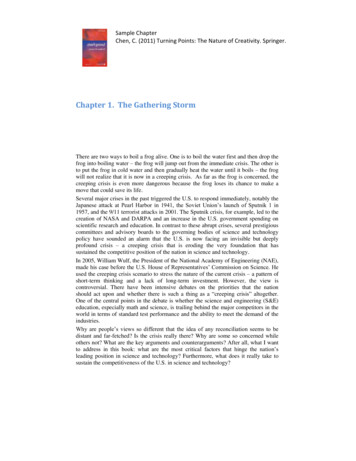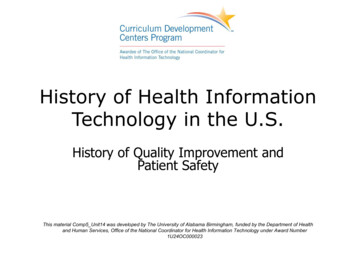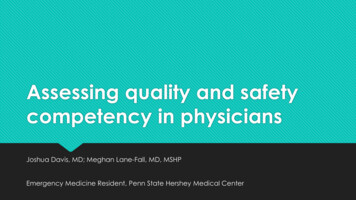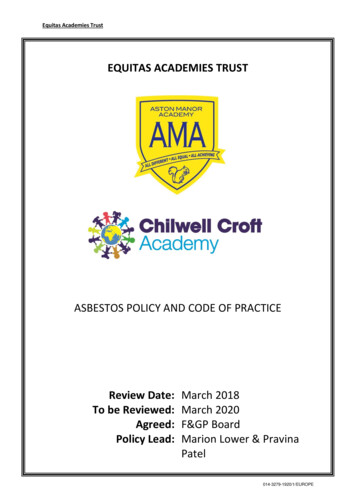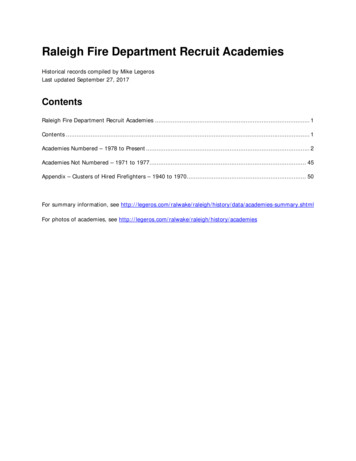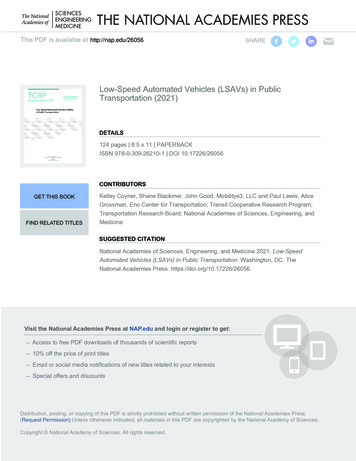
Transcription
THE NATIONAL ACADEMIES PRESSThis PDF is available at http://nap.edu/26056SHARE Low-Speed Automated Vehicles (LSAVs) in PublicTransportation (2021)DETAILS124 pages 8.5 x 11 PAPERBACKISBN 978-0-309-26210-1 DOI 10.17226/26056CONTRIBUTORSGET THIS BOOKFIND RELATED TITLESKelley Coyner, Shane Blackmer, John Good, Mobilitye3, LLC and Paul Lewis, AliceGrossman, Eno Center for Transportation; Transit Cooperative Research Program;Transportation Research Board; National Academies of Sciences, Engineering, andMedicineSUGGESTED CITATIONNational Academies of Sciences, Engineering, and Medicine 2021. Low-SpeedAutomated Vehicles (LSAVs) in Public Transportation. Washington, DC: TheNational Academies Press. https://doi.org/10.17226/26056.Visit the National Academies Press at NAP.edu and login or register to get:– Access to free PDF downloads of thousands of scientific reports– 10% off the price of print titles– Email or social media notifications of new titles related to your interests– Special offers and discounts Distribution, posting, or copying of this PDF is strictly prohibited without written permission of the National Academies Press.(Request Permission) Unless otherwise indicated, all materials in this PDF are copyrighted by the National Academy of Sciences.Copyright National Academy of Sciences. All rights reserved.
Low-Speed Automated Vehicles (LSAVs) in Public TransportationTRANSIT COOPERATIVE RESEARCH PROGRAMTCRP RESEARCH REPORT 220Low-Speed Automated Vehicles (LSAVs)in Public TransportationKelley CoynerShane BlackmerJohn GoodMobilitye3, LLCArlington, VAPaul LewisAlice GrossmanEno Center for TransportationWashington, DCSubject AreasPublic Transportation Passenger Transportation Planning and ForecastingResearch sponsored by the Federal Transit Administration in cooperation with the Transit Development Corporation2021Copyright National Academy of Sciences. All rights reserved.
Low-Speed Automated Vehicles (LSAVs) in Public TransportationTRANSIT COOPERATIVE RESEARCH PROGRAMTCRP RESEARCH REPORT 220The nation’s growth and the need to meet mobility, environmental,and energy objectives place demands on public transit systems. Current systems, some of which are old and in need of upgrading, mustexpand service area, increase service frequency, and improve efficiencyto serve these demands. Research is necessary to solve operating problems, adapt appropriate new technologies from other industries, andintroduce innovations into the transit industry. The Transit Cooperative Research Program (TCRP) serves as one of the principal means bywhich the transit industry can develop innovative near-term solutionsto meet demands placed on it.The need for TCRP was originally identified in TRB Special Report213—Research for Public Transit: New Directions, published in 1987and based on a study sponsored by the Urban Mass TransportationAdministration—now the Federal Transit Administration (FTA). Areport by the American Public Transportation Association (APTA),Transportation 2000, also recognized the need for local, problemsolving research. TCRP, modeled after the successful National Cooperative Highway Research Program (NCHRP), undertakes researchand other technical activities in response to the needs of transit service providers. The scope of TCRP includes various transit researchfields including planning, service configuration, equipment, facilities,operations, human resources, maintenance, policy, and administrativepractices.TCRP was established under FTA sponsorship in July 1992. Proposedby the U.S. Department of Transportation, TCRP was authorized aspart of the Intermodal Surface Transportation Efficiency Act of 1991(ISTEA). On May 13, 1992, a memorandum agreement outlining TCRPoperating procedures was executed by the three cooperating organizations: FTA; the National Academies of Sciences, Engineering, andMedicine, acting through the Transportation Research Board (TRB);and the Transit Development Corporation, Inc. (TDC), a nonprofiteducational and research organization established by APTA. TDC isresponsible for forming the independent governing board, designatedas the TCRP Oversight and Project Selection (TOPS) Commission.Research problem statements for TCRP are solicited periodically butmay be submitted to TRB by anyone at any time. It is the responsibilityof the TOPS Commission to formulate the research program by identifying the highest priority projects. As part of the evaluation, the TOPSCommission defines funding levels and expected products.Once selected, each project is assigned to an expert panel appointedby TRB. The panels prepare project statements (requests for proposals), select contractors, and provide technical guidance and counselthroughout the life of the project. The process for developing researchproblem statements and selecting research agencies has been used byTRB in managing cooperative research programs since 1962. As inother TRB activities, TCRP project panels serve voluntarily withoutcompensation.Because research cannot have the desired effect if products fail toreach the intended audience, special emphasis is placed on disseminating TCRP results to the intended users of the research: transit agencies, service providers, and suppliers. TRB provides a series of researchreports, syntheses of transit practice, and other supporting materialdeveloped by TCRP research. APTA will arrange for workshops, training aids, field visits, and other activities to ensure that results are implemented by urban and rural transit industry practitioners.TCRP provides a forum where transit agencies can cooperativelyaddress common operational problems. TCRP results support andcomplement other ongoing transit research and training programs.Project J-11/Task 27ISSN 2572-3782ISBN 978-0-309-67370-9 2021 National Academy of Sciences. All rights reserved.COPYRIGHT INFORMATIONAuthors herein are responsible for the authenticity of their materials and for obtainingwritten permissions from publishers or persons who own the copyright to any previouslypublished or copyrighted material used herein.Cooperative Research Programs (CRP) grants permission to reproduce material in thispublication for classroom and not-for-profit purposes. Permission is given with theunderstanding that none of the material will be used to imply TRB, AASHTO, FAA, FHWA,FTA, GHSA, NHTSA, or TDC endorsement of a particular product, method, or practice.It is expected that those reproducing the material in this document for educational andnot-for-profit uses will give appropriate acknowledgment of the source of any reprinted orreproduced material. For other uses of the material, request permission from CRP.NOTICEThe research report was reviewed by the technical panel and accepted for publicationaccording to procedures established and overseen by the Transportation Research Boardand approved by the National Academies of Sciences, Engineering, and Medicine.The opinions and conclusions expressed or implied in this report are those of theresearchers who performed the research and are not necessarily those of the TransportationResearch Board; the National Academies of Sciences, Engineering, and Medicine; or theprogram sponsors.This material has not been edited by the National Highway Traffic Safety Administration(NHTSA), and the information contained in this document may not be reflective of NHTSApolicy or procedures, or those of the Department of Transportation.The Transportation Research Board; the National Academies of Sciences, Engineering, andMedicine; and the sponsors of the Transit Cooperative Research Program do not endorseproducts or manufacturers. Trade or manufacturers’ names appear herein solely becausethey are considered essential to the object of the report.Published research reports of theTRANSIT COOPERATIVE RESEARCH PROGRAMare available fromTransportation Research BoardBusiness Office500 Fifth Street, NWWashington, DC 20001and can be ordered through the Internet by going tohttps://www.nationalacademies.organd then searching for TRBPrinted in the United States of AmericaCopyright National Academy of Sciences. All rights reserved.
Low-Speed Automated Vehicles (LSAVs) in Public TransportationThe National Academy of Sciences was established in 1863 by an Act of Congress, signed by President Lincoln, as a private, nongovernmental institution to advise the nation on issues related to science and technology. Members are elected by their peers foroutstanding contributions to research. Dr. Marcia McNutt is president.The National Academy of Engineering was established in 1964 under the charter of the National Academy of Sciences to bring thepractices of engineering to advising the nation. Members are elected by their peers for extraordinary contributions to engineering.Dr. John L. Anderson is president.The National Academy of Medicine (formerly the Institute of Medicine) was established in 1970 under the charter of the NationalAcademy of Sciences to advise the nation on medical and health issues. Members are elected by their peers for distinguished contributionsto medicine and health. Dr. Victor J. Dzau is president.The three Academies work together as the National Academies of Sciences, Engineering, and Medicine to provide independent,objective analysis and advice to the nation and conduct other activities to solve complex problems and inform public policy decisions.The National Academies also encourage education and research, recognize outstanding contributions to knowledge, and increasepublic understanding in matters of science, engineering, and medicine.Learn more about the National Academies of Sciences, Engineering, and Medicine at www.nationalacademies.org.The Transportation Research Board is one of seven major programs of the National Academies of Sciences, Engineering, and Medicine.The mission of the Transportation Research Board is to provide leadership in transportation improvements and innovation throughtrusted, timely, impartial, and evidence-based information exchange, research, and advice regarding all modes of transportation. TheBoard’s varied activities annually engage about 8,000 engineers, scientists, and other transportation researchers and practitioners fromthe public and private sectors and academia, all of whom contribute their expertise in the public interest. The program is supported bystate transportation departments, federal agencies including the component administrations of the U.S. Department of Transportation,and other organizations and individuals interested in the development of transportation.Learn more about the Transportation Research Board at www.TRB.org.Copyright National Academy of Sciences. All rights reserved.
Low-Speed Automated Vehicles (LSAVs) in Public TransportationCOOPERATIVE RESEARCH PROGRAMSCRP STAFF FOR TCRP RESEARCH REPORT 220Christopher J. Hedges, Director, Cooperative Research ProgramsLori L. Sundstrom, Deputy Director, Cooperative Research ProgramsGwen Chisholm Smith, Manager, Transit Cooperative Research ProgramDianne S. Schwager, Senior Program OfficerJarrel McAfee, Senior Program AssistantEileen P. Delaney, Director of PublicationsNatalie Barnes, Associate Director of PublicationsTCRP PROJECT J-11/TASK 27 PANELField of Special ProjectsA. Jeff Becker, Regional Transportation District, Denver, CO (Chair)Rashidi J. Barnes, First Group PLC, Cincinnati, OHRobert Lawrence Bertini, USF Center for Urban Transportation Research, Tampa, FLYuche Chen, University of South Carolina, Columbia, SCBrian Hoeft, Regional Transportation Commission of Southern Nevada, Las Vegas, NVLyndsay Mitchell, City of Arlington, TX, Arlington, TXGregory Rogers, Securing America’s Future Energy, Washington, D.C.Kevin J. Salzer, Jacksonville, FLJarrett William Stoltzfus, Proterra, Walnut, CADanyell Diggs, FTA LiaisonDarnell Chadwick Grisby, APTA LiaisonElizabeth Machek, OST-R/Volpe Center LiaisonTim Weisenberger, SAE International LiaisonAUTHOR ACKNOWLEDGMENTSThis report was written by Shane Blackmer and John Good, both of Mobilitye3, LLC, and Alice Grossman,Ph.D., and Paul Lewis of the Eno Center for Transportation, under the oversight of the Principal Investigator,Kelley Coyner, Mobilitye3. Lisa Nisenson of WGI and Alisyn Malek, Executive Director of the Commissionon the Future of Mobility, an initiative of Securing America’s Future Energy (SAFE), provided additionaltechnical consultation. The researchers especially wish to thank the more than 200 individuals, agencies, andcompanies that took the time to contribute their knowledge and insights during the interviews and site visitsthat are at the heart of this research.Copyright National Academy of Sciences. All rights reserved.
Low-Speed Automated Vehicles (LSAVs) in Public TransportationFOREWORDBy Dianne S. SchwagerStaff OfficerTransportation Research BoardInterest in driverless vehicles, including low-speed automated vehicles (LSAVs), continuesto expand globally and in the United States. TCRP Research Report 220: Low-Speed Automated Vehicles (LSAVs) in Public Transportation presents current use cases for LSAVsand provides a Practitioner Guide for planning and implementing LSAV services as a newpublic transpor tation service. The audience for this research includes public transit agencies,communities, and private mobility providers seeking to understand how to best incorporateautomated vehicles—and specifically LSAVs—into public transportation service.Research under TCRP Project J-11/Task 27, “Low-Speed Automated Vehicles (LSAV) inPublic Transportation,” was conducted by Mobilitye3, LLC, and the Eno Center for Transportation. The team was asked to (1) conduct scenario analyses of possible use cases for LSAVsthat foster integrated urban mobility; (2) delineate vehicle, technology, and infrastructureattributes required for various LSAV use cases; (3) consider important issues relevant tothe introduction of automated transportation regarding goals, safety, mobility of diversepopulations (including people with disabilities), and benefit measurement; and (4) developguidance, such as a checklist, that presents a decision-making process and rationale forthe effective planning and deploying of LSAV services.The focus of this research was LSAVs, also called automated shuttles. At present, LSAVsare typically low-floor and high-ceiling vehicles that carry four to 10 seated passengers andsome standing passengers at relatively low speeds (i.e., about 15 mph). While the vehiclesdo not require a driver and have SAE Level 4 automation, they typically have an attendantto help passengers and oversee the safe operations of service. Generally (but not always),LSAVs currently operate in controlled environments such as office parks, campuses, andtheme parks and on simple circulator routes. To date, LSAVs do not operate in complexmixed traffic or on demand. The future of LSAVs is unknown, but many of the abovecharacteristics may change as vehicles, technology, and use cases evolve.The research included a literature review; three detailed case studies on the lessons learnedin pilots conducted in Texas, Nevada, and North Carolina; and 14 mini case studies on otherLSAV projects in the United States. The research team interviewed numerous project sponsors, public agency representatives, researchers, and technology vendors.The Practitioner Guide presents seven key stages for planning and implementing LSAVservices with checklists and resources (available through hyperlinks) that address (1) programfoundations, (2) feasibility, (3) procurement, (4) implementation, (5) operations, (6) monitoring and evaluation, and (7) sustainability.Copyright National Academy of Sciences. All rights reserved.
Low-Speed Automated Vehicles (LSAVs) in Public TransportationCopyright National Academy of Sciences. All rights reserved.
Low-Speed Automated Vehicles (LSAVs) in Public TransportationCONTENTS1Summary5Chapter 1 Introduction56788111.1 Study Background1.2 Research Objectives1.3 Methodology: Lessons-Learned ApproachChapter 2 Use Cases and Operational Design Domainsfor LSAVs2.1 LSAV Use Cases2.2 Operational Design Domains13Chapter 3 LSAV Projects19Chapter 4 4.14.24.34.44.5Current Interest in LSAVs Globally and in the United StatesObjectives for Planning and Implementing LSAV ServicesGovernance and Funding for LSAV ServicesEvolution of LSAVs and ServicesAccessibility Concerns with LSAVsChapter 5 Practitioner Guide5.15.25.35.45.55.65.7LSAV Program Foundations ChecklistFeasibility Study ChecklistProcurement ChecklistImplementation ChecklistOperations ChecklistMonitoring and Evaluation ChecklistSustainability ChecklistChapter 6 Areas for Further Research6.16.26.36.46.56.6Baseline Survey of LSAV Planning and ImplementationPerformance Requirements for LSAVsAccessibility, ADA Standards, Equity, and Universal DesignResource Centers for Best Practices and ResearchMeasurement and Assessment of LSAV ServicesInfrastructure Improvements for More Effective LSAV ApplicationsAcronyms and GlossaryCopyright National Academy of Sciences. All rights reserved.
Low-Speed Automated Vehicles (LSAVs) in Public Transportation38Appendix A Literature Review and Survey52Appendix B Interviews and Roundtable Discussions56Appendix C Interview Outline57Appendix D LSAV Case Studies83Appendix E LSAV Mini Case Studies112Appendix F Canadian ProjectsCopyright National Academy of Sciences. All rights reserved.
Low-Speed Automated Vehicles (LSAVs) in Public TransportationSUMMARYLow-Speed Automated Vehicles(LSAVs) in Public TransportationThe automation of mobility is complex, unpredictable, and potentially transformative. Public transit agencies and private mobility providers seek to understand how bestto incorporate automated vehicles—specifically low-speed automated vehicles (LSAVs)—into public transportation service. Many public and private entities have experimentedwith LSAVs in a range of applications. At the same time, the manufacturers of LSAVs areexpanding vehicle and service types.Vehicular automation is a dynamic topic in that technologies and policies may changerapidly. Public transit agencies wishing to explore LSAV services may consult with relevantfederal, state, or local authorities on policy. This research was conducted under thedirection of a panel with expertise in public transportation, mobility innovation, andresearch.Research Objectives and ApproachThe objectives of this research were to (1) provide public transit agencies and communities with guidance about the deployment of LSAVs as a new public transportation serviceand a step toward automated mobility on demand, (2) present use cases for LSAVs thatmay evolve, and (3) provide a checklist for planning and implementing LSAVs. Througha literature review, interviews, and project assessments, this research developed practicalguidance for public transit agencies on emerging LSAV technology, lessons learned fromearly implementations, and considerations for LSAV projects in public transportation. Thereport addressesLSAV service applications. Emerging vehicle types and service models and how toconsider their use in varied operating environments. Guidance for developing LSAV projects. LSAV projects in public transportation,including planning, funding, implementation, and evaluation. LSAVs vary in speed, level of automation, size, and whether the vehicle and the servicemust comply with the ADA as amended (ADA 42 U.S. Code §12101 et seq.) For purposesof this study, “LSAV” refers to vehicles that reach speeds between 15 and 35 mph, are highlyautomated (Level 4 of 5, as defined by SAE), and operate as a shared service. LSAV types andsizes, or “form factors,” are expanding with the emergence of smaller scooter-like vehiclesand larger buses (along with the attendant federal regulations).Project research identified varied LSAV use cases currently being planned and implemented by public and private entities that do not provide public transportation, as well as1Copyright National Academy of Sciences. All rights reserved.
Low-Speed Automated Vehicles (LSAVs) in Public Transportation2 Low-Speed Automated Vehicles (LSAVs) in Public Transportationby public transit agencies. Two important attributes of these use cases are service modelsand trip purposes:Service models. The service models include fixed routes, circulators, shuttles, first/lastmile feeder services, and paratransit and other on-demand mobility options. These service models may operate separately or be combined. Trip purposes. LSAV services for specific types of trips are being planned and pilotedby organizations that are not public transportation providers. These trips include servicesfor health care, employment, entertainment, recreation, retail, parking access, residentialdevelopment, and senior social services. In the future, public transit agencies as well asother public and private providers may offer LSAV service to provide general mobility forany trip in the public right-of-way. The report explains the importance of the operational design domain (ODD) for LSAVs.An ODD comprises the operating conditions under which a given driving automation system or feature is specifically designed to function. Conditions may include speed, weather,topography, time-of-day restrictions, and the requisite presence or absence of certain traffic orroadway characteristics. This research identified vehicle speed; weather; and traffic, roadwaycharacteristics, and roadway conditions as key ODD aspects for practitioners to evaluate whenconsidering LSAV service:Vehicle speed. As the name “low-speed automated vehicles” suggests, practitioners willneed to account for posted speed and operational speed, as well as the speed of othervehicles in mixed traffic in the same right-of-way. Weather. Practitioners may find that heat, snow, and rain require mitigation or limitoperations. Traffic, roadway characteristics, and roadway conditions. Depending on the design of aspecific vehicle, LSAVs can travel in mixed traffic with a range of crossings (e.g., unprotectedturns, controlled stops, and signalized intersections). Modifications to physical infrastructureor the addition of connected vehicle technology can mitigate the hazards these attributespresent. On the basis of a review of procurement and grant applications, as well as stakeholderinterviews, this research found that a rising number of communities in the United States areexploring how LSAVs can help them achieve their transportation, mobility, and economicdevelopment goals. LSAV projects have ranged from short pilots with simple use cases tomultiphase deployment strategies, in which communities are using LSAVs as a key part of thetransportation system. Further, communities are deploying LSAVs in a variety of operatingenvironments and ODDs.This research examines U.S.-based LSAV projects that have been planned, implemented,or completed. The projects ranged between 2 and 15 months’ duration; no demonstrationsof shorter duration were included. Project status is defined in one of three categories:Planning. Projects in active concept development, route planning, or approvals beforetheir official launch, including projects in testing. Operational. Projects currently operating, which generally involves transporting passengers or fulfilling the goals of the program. Completed. Projects that have finished. Key Findings and Lessons LearnedThis research on the evolution of interest in LSAV services in the United States and lessons learned from their initial planning and implementation informs findings and guidancefor practitioners. Key findings address:Copyright National Academy of Sciences. All rights reserved.
Low-Speed Automated Vehicles (LSAVs) in Public TransportationSummary 3 Current global and U.S. interest in LSAVs. Global and U.S. interest in LSAVs continuesto expand, along with the start up of LSAV services. To date, most LSAV service planning,development, testing, and initiation has been by public and private entities other thanpublic transportation agencies. In most cases, LSAV services, although publicly available,serve tightly targeted trip purposes. Evidence of continued interest and support for LSAVservice expansion includes the following:– Vendors have secured on-road testing approvals for additional vehicles.– At least one public transit agency has identified ways in which LSAV service can supportlogistics, such as moving COVID-19 testing samples.– NHTSA has issued Nuro a temporary 2-year exemption from the Federal Motor VehicleSafety Standards (FMVSS). This exemption is the first issued for any automated vehicle,including an LSAV (albeit for a vehicle designed for cargo instead of passengers).Objectives for planning and implementing LSAV services. Long-range transportationplans (LRTPs) have identified improved mobility as a key objective for LSAV services, yetthe objectives for most metropolitan planning organizations (MPOs), cities, and publictransit agencies are to introduce and understand automated technologies and to pursueeconomic development.Management, oversight, and funding for LSAV services. LSAV service management,oversight, and funding throughout the United States are currently through various public–private collaborations. Since early pilots at Fort Bragg and the Smart Cities Challenge heldin 2016, few sustained LSAV projects or pilots in the United States have been led directly bya public transit agency.Evolution of LSAVs and services. LSAV models and services are evolving as they arepiloted. Existing vehicles are being modified, new vehicle models are being introduced,and new services are being considered and planned. Technological capabilities of LSAVsand use cases related to public transportation are intertwined. Although this research onLSAV technology and services represents a snapshot in time, it reveals that technology anduse cases are evolving as LSAVs move from prototype to production.Accessibility and LSAVs. Though FTA has not issued guidance defining accessibilityfor LSAV models or services, it has issued an FAQ on transit bus automation.1 To date,no LSAV models have been designed or retrofitted to include all features for customerswith disabilities, such as wheelchair ramps, securement devices, and rails. Some LSAVmanufacturers have begun to include ramps and wheelchair securement; others haveadded human–machine interfaces (HMIs) to allow customers with cognitive, visual, andauditory disabilities to communicate with the vehicle. Federal and state governments havefunded prototype accessible automated vehicles through both design challenges and assistive technology initiatives.Practitioner GuideThis research confirmed that practitioners want guidance about planning and implementing LSAV service, as well as additional research on LSAVs.The research informed the checklists for key LSAV project stages in Chapter 5, the Practitioner Guide. The key stages are LSAV program foundations, feasibility, procurement,implementation, operations, monitoring and evaluation, and building for sustainability.Each checklist features examples or models of transportation planning, procurement, funding,safety, and operations approaches. Figure S.1 highlights the key elements.1FTA, “Transit Bus Automation Policy FAQs,” November 1, 2019, ansitbus-automation-policy-faqs.Copyright National Academy of Sciences. All rights reserved.
Low-Speed Automated Vehicles (LSAVs) in Public Transportation4 Low-Speed Automated Vehicles (LSAVs) in Public TransportationFigure S.1. Key elements of the Practitioner Guide.Future ResearchFuture research in several areas could increase the transit industry’s capacity for planningfor and managing LSAVs. Key outcomes of further research include Establishing a baseline of LSAV planning and implementation in transit and related publicagencies, including cities, MPOs, and state departments of transportation.Developing performance requirements for LSAVs, related data tools, and training forsafety operators.Creating an inventory of strategies to maximize accessibility through ADA standards,equity of access, and universal design, including assistive technologies.Establishing a resource center to support ongoing collaboration on best practices.Identifying and validating metrics and evaluation tools for LSAV services in publictransportation.Copyright National Academy of Sciences. All rights reserved.
Low-Speed Automated Vehicles (LSAVs) in Public TransportationCHAPTER 1IntroductionThe development of automated vehicles is complex, challenging transportation professionalsto keep up with the state of the technology and its uses; federal, state, and local policy; and bestpractices in planning and deployment. This research builds on the various trials of different levelsof automated technology across several categories of vehicles operating at a range of speeds.In particular, the research examined low-speed automated vehicles (LSAVs) already deployedon public roads as shared mobility services. This research provided an opportunity to explorefuture operation of LSAVs as public transportation.Vehicular automation is a dynamic topic in that technologies and policies may change rapidly.Public transit agencies wishing to explore LSAV services may consult with relevant federal, state,or local authorities on policy. This research was conducted under the direction of a panel withexpertise in public transportation, mobility innovation, and research.The technology for automated vehicles moves forward alongside new business and servicemodels in the transportation portion of the sharing economy. This convergence signals the potential for accelerated deployment of shared automated vehicles in more densely populated areas,especially for vehicles operating at speeds less than 35 mph.1.1 Study BackgroundIn August 2018, a report by Volpe National Tra
and the Transit Development Corporation, Inc. (TDC), a nonprofit educational and research organization established by APTA. TDC is responsible for forming the independent governing board, designated as the TCRP Oversight and Project Selection (TOPS) Commission. . Brian Hoeft, Regional Transportation Commission of Southern Nevada, Las Vegas .




